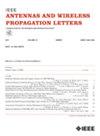基于寄生像素条的宽带多波束平面准八木阵列天线
IF 4.8
2区 计算机科学
Q2 ENGINEERING, ELECTRICAL & ELECTRONIC
引用次数: 0
摘要
这封信提出了一种低复杂度的寄生像素条(PPS)结构,用于阵列天线产生六种具有柔性波束控制的辐射。为了实现多波束工作,在馈电天线中集成了三组对称的条形像元,其连接状态可由p-i-n二极管控制。利用可重构的寄生结构,可以对天线的耦合路径进行策略控制,从而实现所需的多波束特性。因此,通过将PPS结构与平面准八木天线结合使用,该单天线可以在4种状态下工作,波束方向为40°,- 40°,0°,以及双波束方向为±45°,频率范围为5.0 GHz至5.6 GHz。此外,还制作了具有PPS结构的1 × 2阵列原型,实现了扫描范围为40°,20°,0°,- 20°,- 40°的六波束和±30°的双波束。值得注意的是,仅使用4个p-i-n二极管实现6个辐射,验证了该方法有效地减少了开关的过度使用并扩展了波束的多样性,为多波束阵列天线提供了一种低复杂度的方法,而无需复杂的波束形成网络。这些天线具有宽带、规划结构、结构复杂度低、成本低、波束控制灵活等优点。本文章由计算机程序翻译,如有差异,请以英文原文为准。
A Wideband Multibeam Planar Quasi-Yagi Array Antenna Based on Parasitic Pixel Strips
This letter presents a low-complexity parasitic pixel strip (PPS) structure for an array antenna to generate six radiations with flexible beam control. To realize multibeam operation, three groups of symmetrical strip-shaped pixels are integrated with the feed antenna, the connection state of which can be controlled by p-i-n diode. Leveraging the reconfigurable parasitic configuration, the coupling path of the antenna can be strategically manipulated, achieving the desired multibeam property. Thus, by utilizing the PPS structure in conjunction with a planar quasi-Yagi antenna, this single antenna can operate at four states with beam direction toward 40°, −40°, 0°, along with a dual-beam at ±45°, within the frequency range from 5.0 GHz to 5.6 GHz. Moreover, a prototype of a 1 × 2 array with the PPS structure is also fabricated to achieve six beams with a scan range of 40°, 20°, 0°, −20°, −40° and a dual beam at ±30°. Notably, only four p-i-n diodes are utilized to implement six radiations, verifying that this approach effectively minimizes the excessive use of switches and extends the variety of beams, which provides a low complexity method for multibeam array antenna without a complicated beamforming network. These antennas satisfy the benefits of wideband, planner structure, low structural complexity, low cost, and flexible beam control.
求助全文
通过发布文献求助,成功后即可免费获取论文全文。
去求助
来源期刊
CiteScore
8.00
自引率
9.50%
发文量
529
审稿时长
1.0 months
期刊介绍:
IEEE Antennas and Wireless Propagation Letters (AWP Letters) is devoted to the rapid electronic publication of short manuscripts in the technical areas of Antennas and Wireless Propagation. These are areas of competence for the IEEE Antennas and Propagation Society (AP-S). AWPL aims to be one of the "fastest" journals among IEEE publications. This means that for papers that are eventually accepted, it is intended that an author may expect his or her paper to appear in IEEE Xplore, on average, around two months after submission.

 求助内容:
求助内容: 应助结果提醒方式:
应助结果提醒方式:


